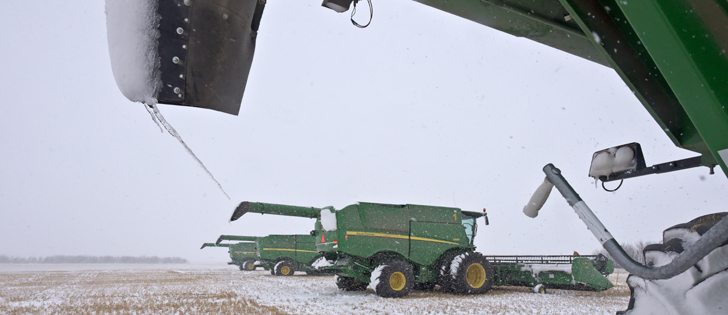There’s good news and bad news for weather-weary farmers who are still hoping to harvest what’s left of this year’s rapidly deteriorating crop.
The good news is that a significant amount of the prairie crop often comes off in October or even early November, says Daphne Cruise, provincial crop specialist with Saskatchewan Agriculture.
The bad news is that Mother Nature still deals the cards.
And the hands she deals in late October and November are much more likely to be filled with unmatched threes and fours, as opposed to aces and deuces.
Read Also

Feds propose overhaul of chronic wasting disease control program
Chronic Wasting disease control program getting updated by Canadian Food Inspection Agency with feedback encouraged from producers.
“I’m still optimistic,” said Cruise.
“A week long (weather) system for sure doesn’t help, but I think there’s still time to get the crop off before … winter weather sets in.”
Concerns over harvest progress and crop quality have now reached the point of desperation across a huge swath of the prairie grain belt.
A massive, slow-moving low pressure system that pushed into Saskatchewan from the southwest Oct. 3 dumped as much as 50 millimetres of rain and close to 30 centimetres of snow over much of the province this week.
Growers with crop in the field are still assessing the damage and wondering if there’s any hope that this year’s harvest will reach the point of substantial completion before the spring thaw.
In some areas, a prolonged cold spell and hard frozen ground might be preferable to a slow, messy thaw in late October.
Eighty percent of the crop had been harvested in Saskatchewan this week.
The remaining 20 percent will almost certainly be a slow, mucky grind that yields a high proportion of low-quality, high-moisture grain.
Saskatchewan’s spring wheat crop, excluding durum, was 79 percent complete as of this week.
With province-wide non-durum plantings estimated at 7.1 million acres this year, that leaves 1.4 to 1.5 million acres of wheat — as much as 60 to 70 million bushels — still in the field.
The vast majority of that will be destined for feed or — with luck — low quality milling markets.
The province’s durum harvest was even further behind at 74 percent complete (roughly 1.25 million acres remaining), oats at 75 percent harvested (345,000 acres remaining) and the provincial canola crop — pegged at nearly 11 million acres this year — at 77 percent harvested with nearly 2.5 million acres still to be combined.
Despite the shorter working days and cooler daytime temperatures that are sure to follow, Cruise said harvest records from the past provide at least a glimmer of hope.
For example, Saskatchewan’s 2009 harvest was 80 percent complete by the end of October, she said.
Close to 20 percent came off in November.
Marketing efforts could also be a challenge this year.
Saskatchewan’s spring wheat grades as of Oct. 3 were already below the 10-year average, according to Saskatchewan Agriculture’s first provincial crop report in October.
About 10 percent of the harvested spring wheat was expected to grade No. 1 CW. Another 50 percent was grading No. 2, 28 percent was No. 3 and 12 percent was feed, according to provincial data.
By some estimates, one-quarter to one-third of this year’s near-record provincial wheat harvest could be sold as feed.
Cruise said heavy snowfall this week will affect the quality and harvestability of all remaining crops, but cereals will suffer the most.
“It’s not great for the cereals that are still out there,” she said.
“They were already being downgraded because of fusarium … so now it’s going to be fusarium on top of sprouting and bleaching and kernel soundness.”
Daryl Beswitherick, quality manager with the Canadian Grain Commission, agreed that harvest prospects going forward don’t look great.
In addition to the storm that hammered Saskatchewan, many growers in the Peace River region of Alberta and British Columbia also received close to 30 cm of snow and many growers in Alberta and Manitoba have been sidelined because of rain.
“We saw mildew prior to the rain and now we’re seeing more moisture,” Beswitherick said.
“The remaining crop isn’t going to get any better.”
Contact brian.cross@producer.com
















